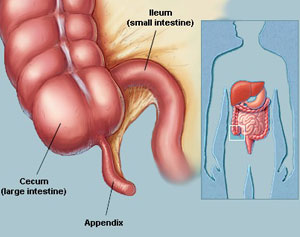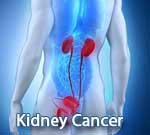Appendix Treatment India
The appendix is a small hollow tube attached to the large colon (the large colon is also called large bowel or large intestine). The appendix is approximately 4 inches long and shaped like a worm. The appendix serves no known purpose, although it is thought to possibly play a role in the immune system. Very rarely, the appendix may become cancerous. Since the appendix is attached to the colon, appendix cancer is considered a type of colorectal cancer. Colorectal cancers are also part of a larger group of cancers of gastrointestinal tract, or GI cancers.
Cancer of the appendix may cause appendicitis or cause the appendix to rupture. Sometimes this is the first symptom of appendix cancer. A ruptured appendix may cause a very serious condition called peritonitis, which is an infection of the lining of the abdomen and pelvis. A cancerous tumor of the appendix may also "seed" the abdomen with cancer cells. This may cause more cancerous tumors to develop in the abdomen before it is discovered. See Peritoneal Surface Malignancies and Peritoneal Carcinomatosis. Many times there are no symptoms of appendix cancer until it has progressed and is advanced. Abdominal discomfort and bloating of the abdomen can be signs of advanced appendiceal cancer
There are five most common (though still VERY rare) varieties of appendix cancer: Malignant Carcinoid, Mucinous Adenocarcinoma, Adenocarcinoma, Adenocarcinoid, and Signet Ring Adenocarcinoma. To learn more about these varieties of appendix cancer, treatment and prognosis, click the links here or on the left side of this screen.
Phone Numbers Reach Us -
India & International : +91 9371770341
Diagnosis and treatment :
 Appendix cancer has often spread to the peritoneal surfaces of the abdomen by the time it is discovered. The surgery to remove as much of the cancer in the abdomen as possible, reducing the "bulk" of the cancer is called "debulking" or "cytoreduction" surgery. "Cyto" is a word root meaning cells, so cytoreduction means to surgically "reduce" number of cancer cells. Both terms mean the same thing and are usually used interchangeably.
Cytoreduction (debulking) surgery is often long and complicated and is associated with a high rate of post-operative complications. Parts of the large and small bowel along with organs or parts of organs in the abdomen that are cancerous may need to be removed during this surgery. "Complete cytoreduction" or "complete debulking" means that all of the visible tumors are successfully removed during surgery. "Incomplete cytoreduction" or "incomplete debulking" means that all of the tumors could not be removed during the surgery and that visible tumors were left behind.
Appendix cancer has often spread to the peritoneal surfaces of the abdomen by the time it is discovered. The surgery to remove as much of the cancer in the abdomen as possible, reducing the "bulk" of the cancer is called "debulking" or "cytoreduction" surgery. "Cyto" is a word root meaning cells, so cytoreduction means to surgically "reduce" number of cancer cells. Both terms mean the same thing and are usually used interchangeably.
Cytoreduction (debulking) surgery is often long and complicated and is associated with a high rate of post-operative complications. Parts of the large and small bowel along with organs or parts of organs in the abdomen that are cancerous may need to be removed during this surgery. "Complete cytoreduction" or "complete debulking" means that all of the visible tumors are successfully removed during surgery. "Incomplete cytoreduction" or "incomplete debulking" means that all of the tumors could not be removed during the surgery and that visible tumors were left behind.
The factor most associated with long term survival is completeness of cytoreduction, or the removal of all visible tumors. Cytoreduction (debulking) surgery is best done by a surgical oncologist who specializes in these types of surgeries. A list of some of the specialists can be found on this page: Physicians and Facilities Treating Appendix Cancer.
If all of the tumors cannot be removed, there is less likely hood of survival unless the tumors left behind are very small (less than 2.5mm or about 1/8th of an inch). To destroy very small tumors and cancer cells left behind that are too small to be seen, and to prevent them from later growing into new cancerous tumors in the abdomen, the surgery can be followed by treatment with intraoperative Hyperthermic Intraperitoneal Chemotherapy (HIPEC) or by treatment with early post-operative intraperitoneal chemotherapy (EPIC) at facilities that have the capability to provide these treatments. These chemotherapy treatments may be effective on very tiny tumors that cannot be removed, but are not able to completely destroy larger tumors left behind.
Debulking surgeries can take 12 hours or more and require very large incisions. MOAS is a nickname given to the surgery by a patient who had the procedure done and named it the "Mother Of All Surgeries", and the acronym stuck in some internet circles.
When intravenous chemotherapy (IV chemo) is indicated for the treatment of appendiceal cancer, the specific drugs used are usually the same as those used to treat colon cancer. Appendiceal cancer is so uncommon that clinical trials comparing the effectiveness of the various available chemotherapy agents have not been done. Since colon cancer and appendiceal cancer pathologies are similar, the effectiveness of these chemotherapy medications is assumed to be beneficial in the treatment of appendiceal cancer, and in many cases it has been demonstrated to be effective. Most often combinations of several drugs are used. Acronyms for these combinations are listed below.
A personal note based on my own experience; if while receiving chemotherapy you experience any side effects, bring them to the attention of your doctor or chemo nurse right away. Most side effects can be controlled once they are brought to the attention of your health care provider. It is possible to lead a very normal life and in many cases to be able to continue to work while on chemotherapy. Be sure if you are a female of child-bearing age to discuss the effects of your chemotherapy on fertility and to ask your doctor about contraception. All chemotherapies may cause some weakness and tiredness in some people, especially on the day of treatment.
Follow up :
Following cytoreduction surgery and/or peritoneal chemotherapy and possibly IV chemotherapy for appendix cancer, testing will be done periodically to evaluate for possible cancer recurrence.
- CT scans will usually be done approximately 3 months after surgery initially, then usually every 6 months for the next 3-5 years, followed by yearly scans at the discretion of the surgeon and/or oncologist.
- PET scans may also be done at the discretion of the attending surgeon/oncologist.
- Tumor markers may be evaluated every 3-6 months, again, depending on the preference of the surgeon or oncologist.
- While on chemotherapy and for a period of time following chemotherapy, blood tests will also be done to evaluate the effect of chemotherapy on blood counts.
- A periodic comprehensive physical exam by a physician and evaluation of any symptoms is also extremely important
Several tests are used in the diagnosis of cancer and for monitoring a patient following treatment for appendiceal cancer and peritoneal carcinomatosis. These include:
Biopsy:
a biopsy is a test in which tissue from a tumor is removed and visualized under a microscope. A biopsy determines whether a tumor is benign (not cancer) or malignant (cancer). Cancerous tumors are graded from 1 to 4. Low grade tumors are considered less invasive and to grow more slowly, so have a better prognosis. High grade tumors are considered to be faster growing and more invasive, so have a poorer prognosis
- Grade 1 tumors are well-differentiated (resemble normal tissue more closely). These are considered low grade cancers
- Grade 2 tumors are moderately differentiated and are considered intermediate grade tumors
- Grade 3 tumors are poorly differentiated and are considered high grade tumors
- Grade 4 undifferentiated tumors, considered high grade tumors
Phone Numbers Reach Us -
India & International : +91 9371770341





































